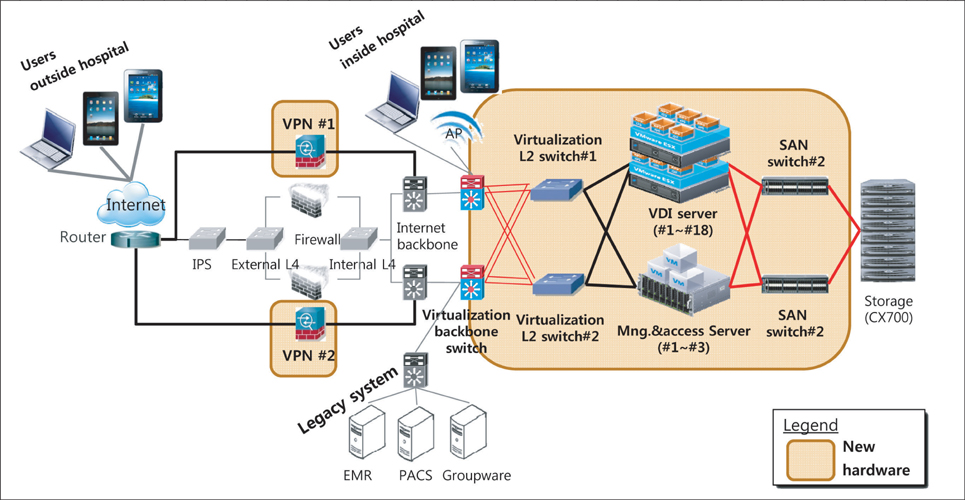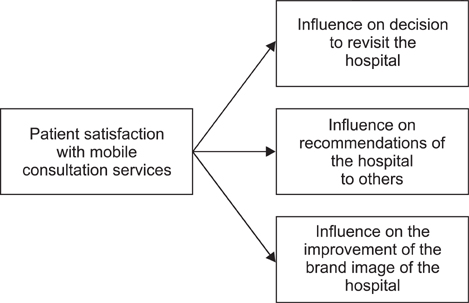Healthc Inform Res.
2012 Dec;18(4):259-565. 10.4258/hir.2012.18.4.259.
Implementation Issues of Virtual Desktop Infrastructure and Its Case Study for a Physician's Round at Seoul National University Bundang Hospital
- Affiliations
-
- 1Center for Medical Informatics, Seoul National University Bundang Hospital, Seongnam, Korea. neuroandy@snubh.org
- 2Department of Pediatrics, Seoul National University Bundang Hospital, Seongnam, Korea.
- 3Department of Plastic Surgery, Seoul National University Bundang Hospital, Seongnam, Korea.
- 4Department of Obstetrics and Gynecology, Seoul National University Bundang Hospital, Seongnam, Korea.
- 5Department of Orthopedics, Seoul National University Bundang Hospital, Seongnam, Korea.
- KMID: 2284560
- DOI: http://doi.org/10.4258/hir.2012.18.4.259
Abstract
OBJECTIVES
The cloud computing-based virtual desktop infrastructure (VDI) allows access to computing environments with no limitations in terms of time or place such that it can permit the rapid establishment of a mobile hospital environment. The objective of this study was to investigate the empirical issues to be considered when establishing a virtual mobile environment using VDI technology in a hospital setting and to examine the utility of the technology with an Apple iPad during a physician's rounds as a case study.
METHODS
Empirical implementation issues were derived from a 910-bed tertiary national university hospital that recently launched a VDI system. During the physicians' rounds, we surveyed patient satisfaction levels with the VDI-based mobile consultation service with the iPad and the relationship between these levels of satisfaction and hospital revisits, hospital recommendations, and the hospital brand image. Thirty-five inpatients (including their next-of-kin) and seven physicians participated in the survey.
RESULTS
Implementation issues pertaining to the VDI system arose with regard to the highly availability system architecture, wireless network infrastructure, and screen resolution of the system. Other issues were related to privacy and security, mobile device management, and user education. When the system was used in rounds, patients and their next-of-kin expressed high satisfaction levels, and a positive relationship was noted as regards patients' decisions to revisit the hospital and whether the use of the VDI system improved the brand image of the hospital.
CONCLUSIONS
Mobile hospital environments have the potential to benefit both physicians and patients. The issues related to the implementation of VDI system discussed here should be examined in advance for its successful adoption and implementation.
Keyword
MeSH Terms
Figure
Reference
-
1. Beaty K, Kochut A, Shaikh H. Desktop to cloud transformation planning. Proceedings of the IEEE International Symposium on Parallel & Distributed Processing. 2009 May 23-29; Rome, Italy. 1–8.
Article2. Miller K, Pegah M. Virtualization: virtually at the desktop. Proceedings of the 35th Annual ACM SIGUCCS Fall Conference. 2007 Oct 7-10; Orlando, FL. 255–260.3. Haroon M, Yasin F, Eckel R, Walker F. Perceptions and attitudes of hospital staff toward paging system and the use of mobile phones. Int J Technol Assess Health Care. 2010. 26(4):377–381.
Article4. Chatterjee S, Chakraborty S, Sarker S, Sarker S, Lau FY. Examining the success factors for mobile work in healthcare: a deductive study. Decis Support Syst. 2009. 46(3):620–633.
Article5. Himmelstein DU, Wright A, Woolhandler S. Hospital computing and the costs and quality of care: a national study. Am J Med. 2010. 123(1):40–46.
Article6. Rosenthal A, Mork P, Li MH, Stanford J, Koester D, Reynolds P. Cloud computing: a new business paradigm for biomedical information sharing. J Biomed Inform. 2010. 43(2):342–353.
Article7. Marston S, Li Z, Bandyopadhyay S, Zhang J, Ghalsasi A. Cloud computing: the business perspective. Decis Support Syst. 2011. 51(1):176–189.8. Verhelle F, Goossens P, van Den Broeck R, Willekens I, Kellen J, de Mey J. Can we use desktop virtualization to enhance the teleradiology environment? [Internet]. c2012. cited at 2012 Dec 1. Vienna, Austria: Interactive Programme Planner, European Society of Radiology;Available from: http://ipp.myesr.org/esr/ecr2012/index.php?v=posterd&poid=100436&ippwwwsid=5jnho9nq3agreqirle8hkru2l2.9. Karthikeyan N, Sukanesh R. Case study on software as a service (SaaS) based emergency healthcare in India. Eur J Sci Res. 2012. 69(3):461–472.10. Ozturkcan S, Aydin S, Ates M, Cetin AT. Effects of service quality on customer satisfaction and customer loyalty: example of Marmara University Hospital. International Congress on Performance and Quality in Health. 2009 Mar 19-21; Antalya, Turkey.
Article11. Platonova EA, Kennedy KN, Shewchuk RM. Understanding patient satisfaction, trust, and loyalty to primary care physicians. Med Care Res Rev. 2008. 65(6):696–712.
Article12. Otani K, Waterman B, Faulkner KM, Boslaugh S, Burroughs TE, Dunagan WC. Patient satisfaction: focusing on "excellent". J Healthc Manag. 2009. 54(2):93–102.
Article13. Megivern K, Halm MA, Jones G. Measuring patient satisfaction as an outcome of nursing care. J Nurs Care Qual. 1992. 6(4):9–24.
Article14. Lee MA, Yom YH. A comparative study of patients' and nurses' perceptions of the quality of nursing services, satisfaction and intent to revisit the hospital: a questionnaire survey. Int J Nurs Stud. 2007. 44(4):545–555.
Article15. Anbori A, Ghani SN, Yadav H, Daher AM, Su TT. Patient satisfaction and loyalty to the private hospitals in Sana'a, Yemen. Int J Qual Health Care. 2010. 22(4):310–315.
Article16. HIMSS Analytics. Stage 7 Hospitals [Internet]. c2012. cited at 2012 Dec 1. Chicago (IL): HIMSS Analytics;Available from: http://www.himssanalytics.org/emram/stage7Hospitals.aspx.17. Woodside AG, Frey LL, Daly RT. Linking service quality, customer satisfaction, and behavioral intention. J Health Care Mark. 1989. 9(4):5–17.18. Ware JE Jr, Snyder MK. Dimensions of patient attitudes regarding doctors and medical care services. Med Care. 1975. 13(8):669–682.
Article19. Oliver RL, Swan JE. Consumer perceptions of interpersonal equity and satisfaction in transactions: a field survey approach. J Mark. 1989. 53(2):21–35.
Article20. Reidenbach RE, Sandifer-Smallwood B. Exploring perceptions of hospital operations by a modified SERVQUAL approach. J Health Care Mark. 1990. 10(4):47–55.21. Parasuraman A, Zeithaml VA, Berry LL. A conceptual model of service quality and its implications for future research. J Mark. 1985. 49(4):41–50.
Article22. VMware Inc. Key highlight: Huntsville Hospital [Internet]. c2012. cited at 2012 Dec 1. Palo Alto (CA): VMware Inc.;Available from: http://www.vmware.com/files/pdf/customers/07Q3_HuntsvilleHospital_Health_SS_1pgr_R3.pdf.23. VMware Inc. VMware view reference implementation for Norton healthcare [Internet]. c2012. cited at 2012 Dec 1. Palo Alto (CA): VMware Inc.;Available from: http://www.vmware.com/files/pdf/VMware-View-ReferenceImplementation-Norton-EN.pdf.24. Yeo K, Lee K, Kim JM, Kim TH, Choi YH, Jeong WJ, et al. Pitfalls and security measures for the mobile EMR system in medical facilities. Healthc Inform Res. 2012. 18(2):125–135.
Article25. Padhy RP, Patra MR, Satapathy SC. Design and implementation of a cloud based rural healthcare information system model. Univers J Appl Comput Sci Technol. 2012. 2(1):149–157.
- Full Text Links
- Actions
-
Cited
- CITED
-
- Close
- Share
- Similar articles
-
- Does Economic Instability Affect Healthcare Provision? Evidence Based on the Urban Family Physician Program in Iran
- Laboratory Environment Monitoring: Implementation Experience and Field Study in a Tertiary General Hospital
- Technology and Policy Challenges in the Adoption and Operation of Health Information Exchange Systems
- Experimental Production and Implementation of the Pathology Laboratory Teaching Material Using Virtual Microscope
- Virtual Plastic Surgery using Adobe Photoshop(R)



